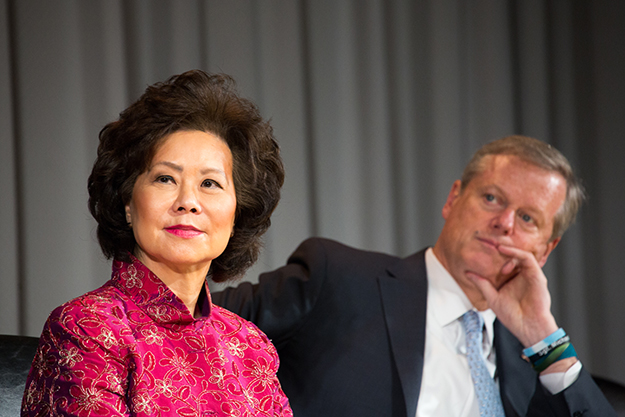
DoT Secretary Elaine Chao, left
WASHINGTON: The Air Force is pulling out all the stops next week to demonstrate the potential utility of ‘flying cars’ to military users across the services, as well as civil agencies within the US government including the Department of Transportation.
The Agility Prime program’s virtual event, being held April 27-May 1 will open with speeches by Air Force Secretary Barbara Barrett, Chief of Staff Gen. David Goldfein, Transportation Secretary Elaine Chao, and Air Force acquisition head Will Roper, who has been championing the idea since last summer.
Some 50 vendors of electric vertical take off and landing (eVTOL) aircraft will be given a chance to strut their stuff to potential buyers across the military services and the US government, Col. Nate Diller, Agility Prime team lead, told reporters today.
The high-powered line-up is a testimony to the Air Force’s dedication to becoming an earlier adopter of flying car technology for moving people and cargo, as commercial actors such as Uber move out on developing designs for the commercial market.
Diller said the Air Force also has been working closely with NASA — which itself has been working with Uber on an eVTOL craft — and the Federal Aviation Administration (FAA) to create operational standards and licensing issues for future vehicles. The FAA regulates US airspace and NASA obviously has expertise in providing safety certification for aircraft and spacecraft carrying people.
Bob Pearce, NASA’s associate administrator for aeronautics research, and Michael Romanowski, the FAA’s policy chief for aircraft certification, will speak at the event as well, Diller said.
Roper sees initial operating capability for Air Force flying cars by 2023.
Agility Prime is first focused on mid-sized eVTOL craft that can carry three to eight people. Diller explained that the service sees potential utility in two other classes of vehicles: very small craft that can carry only one or two people (which he said some vendors are already test flying using FAA licenses applying to ultra-light aircraft); and larger aircraft that could ferry cargo and a large number of people.
The first round of Agility Prime prototype contracting, Diller said, in some cases bounce off the Air Force Small Business Innovation Research (SBIR) Phase I and Phase II contracts already held by some vendors. However, he stressed, the door is wide open to new entries — with next week’s event offering “virtual booths” for newcomers to show off their wares. He would not, however, provide an estimate of planned Air Force spending on the program.
The Air Force also is wooing private sector investors to the event in hopes they will kick in funds to the companies showing the most promise, both technologically and in plans for getting their wares on the street.
As Breaking D readers know, Roper has launched a concerted effort to revamp the service’s approach to SBIR funds, led by the new AFVentures unit, designed to match Air Force funds to investments from venture capital funds and ‘angel’ investors (read, interested rich people.)
Roper has said that he intends for AFVentures to invest about $1 billion a year in some 30 to 40 “game-changing” startups in hopes of helping them vault over the infamous ‘valley of death’ between demonstrating a capability and becoming a DoD program of record.
One of the hallmarks of Roper’s approach to Air Force acquisition chief has been a focus on leveraging commercial research and development to help DoD ensure that it can stay ahead of China in the pursuit of new technology — arguing that ‘innovation is the new battlefield.’
Move over FARA: General Atomics pitching new Gray Eagle version for armed scout mission
General Atomics will also showcase its Mojave demonstrator for the first time during the Army Aviation Association of America conference in Denver, a company spokesman said.


























